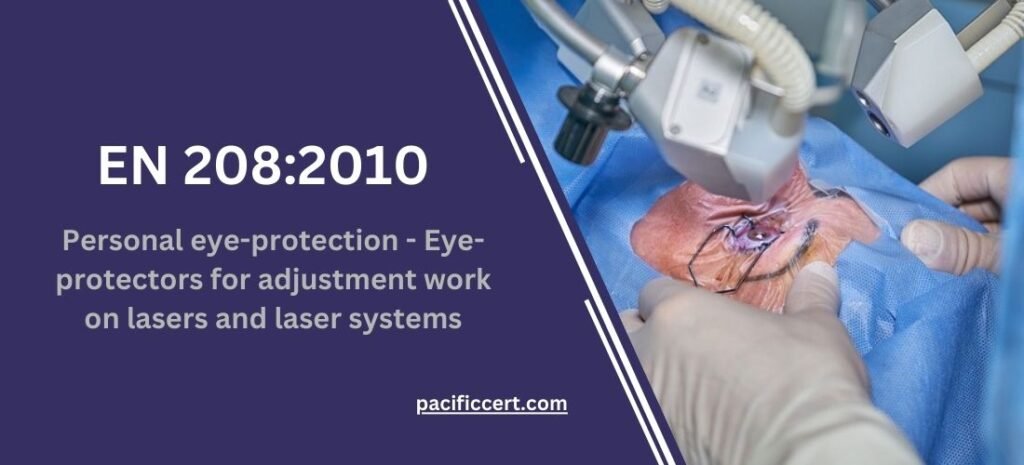
What is EN 208:2010- Personal eye-protection – Eye-protectors for adjustment work on lasers and laser systems?
EN 208:2010- Personal eye-protection is a European standard, specifies the requirements and test methods for eye protectors used during laser adjustment work. The standard applies to all types of lasers and laser systems, including medical, industrial, and scientific lasers.
The standard defines laser adjustment eye protectors as “eye protectors for use during the adjustment of lasers and laser systems, intended to protect the eyes of the wearer from accidental exposure to laser radiation.” The eye protectors covered by the standard include glasses, goggles, and face shields.
It specifies the requirements for the optical properties of the eye protectors. Including the transmission, reflection, and absorption of laser radiation. The standard also sets out requirements for the physical properties of the eye protectors. Such as the resistance to impact and the stability of the frame and lenses.
Therefore, The standard includes test methods for evaluating the optical and physical properties of the eye protectors. Including tests for laser resistance, impact resistance, and optical transmission. The standard also sets out requirements for the labelling and user information provided with the eye protectors.
Requirements of EN 208:2010
Optical properties: The eye protectors must provide adequate protection against laser radiation by reducing the transmission, reflection, and absorption of laser radiation. The optical density of the eye protectors must meet the specified requirements for each laser class.
Physical properties: The eye protectors must be robust and durable, and able to withstand the conditions of laser adjustment work. They must have high impact resistance and be stable under various environmental conditions, including temperature and humidity.
Design requirements: The eye protectors must be designed to fit securely and comfortably on the wearer’s head and provide adequate coverage of the eye area. They must not interfere with the user’s vision or mobility during laser adjustment work.
Labelling and user information: The eye protectors must be labelled with the appropriate laser class and the minimum optical density required for that class. So, the user information provided with the eye protectors must include instructions for use, maintenance, and storage of the eye protectors.
Testing requirements: The eye protectors must undergo various tests to evaluate their optical and physical properties. Including tests for laser resistance, impact resistance, and optical transmission.
Benefits of EN 208:2010
Increased safety: The standard ensures that eye protectors used during laser adjustment work provide adequate protection against laser radiation. Reducing the risk of eye injuries or blindness.
Improved comfort: The eye protectors must be designed to fit securely and comfortably on the wearer’s head and provide adequate coverage of the eye area. Thus, This improves comfort and reduces the likelihood of the user removing the eye protectors, which could increase the risk of eye injury.
Standardization: The standard provides a consistent set of requirements and test methods for eye protectors used during laser adjustment work. Allowing for easy comparison and evaluation of different types of eye protectors.
Compliance with regulations: Many countries have regulations in place requiring the use of eye protectors during laser adjustment work. Compliance with EN 208:2010 ensures that eye protectors meet the required standards. Reducing the risk of non-compliance and associated penalties.
Confidence in performance: The testing requirements of the standard provide assurance that the eye protectors will perform as expected and withstand the conditions of laser adjustment work. Improving user confidence in their effectiveness.
Who needs EN 208:2010- Personal eye-protection – Eye-protectors for adjustment work on lasers and laser systems
EN 208:2010 is intended for anyone involved in laser adjustment work, including engineers, technicians, and other workers who operate or maintain laser systems. This includes workers in a wide range of industries, such as manufacturing, construction, and healthcare, where lasers are used for various applications.
Employers are responsible for ensuring that their workers are provided with appropriate personal protective equipment (PPE) to reduce the risk of work-related injuries. Including eye injuries caused by laser radiation.
Therefore, EN 208 provides guidance on the selection, use, and maintenance of eye protectors specifically designed for laser adjustment work. Helping employers meet their health and safety obligations.
Pacific Certifications is accredited by ABIS, if you need more support with EN 208, please contact us at +91-8595603096 or support@pacificcert.com
Read About: BS EN 197-1:2011









